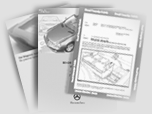|
Preparation for Test
1. Battery voltage > 11 V,
2. Fuses ok,
3. Disconnect battery ground cable prior to connecting or disconnecting
any electrical connector to any control module
(to prevent the storing of erroneous diagnostic trouble codes),
4. HHT Module: "Component Connections",
5. Voltage supply to all the following control modules:
 Circuit 15R from electronic ignition
switch control module (N73) Circuit 15R from electronic ignition
switch control module (N73)
 Electronic ignition switch control
module (N73) Electronic ignition switch control
module (N73)
 Lower control field control module
(N72) Lower control field control module
(N72)
 Front driver-side door control
module (N69/1) Front driver-side door control
module (N69/1)
 Front passenger-side door control
module (N69/2) Front passenger-side door control
module (N69/2)
 Rear driver-side door control
module (N69/3) Rear driver-side door control
module (N69/3)
 Rear passenger-side door control
module (N69/4) and Rear passenger-side door control
module (N69/4) and
6. All CAN data lines ok, see DM, B&A, vol. 2, section 7.1,  23
23
7. Model 208.4 only:
Switch middle console (S21/1) is installed instead of switch N72s1. S21/1
is connected to the Roll bar/power soft top control module (N52).
Electrical wiring diagrams:
Electrical Troubleshooting Manual, Model 202, group 72, 77, 82
Model 208, group 72, 77, 82
Model 210, group 72, 77, 82

Observe version coding for:
Front driver-side door control module (N69/1)
Front passenger-side door control module (N69/2)
Electronic ignition switch control module (N73)
For test measuring purposes, the CAN connection to the following control
modules must be connected:
PSE control module (A37)
Signal pickup-and activation module (SAM) (N10/1)
Model 208
Synchronization of the windows is only possible with the doors closed.
|


 Printable
version
Printable
version


 Printable
version
Printable
version